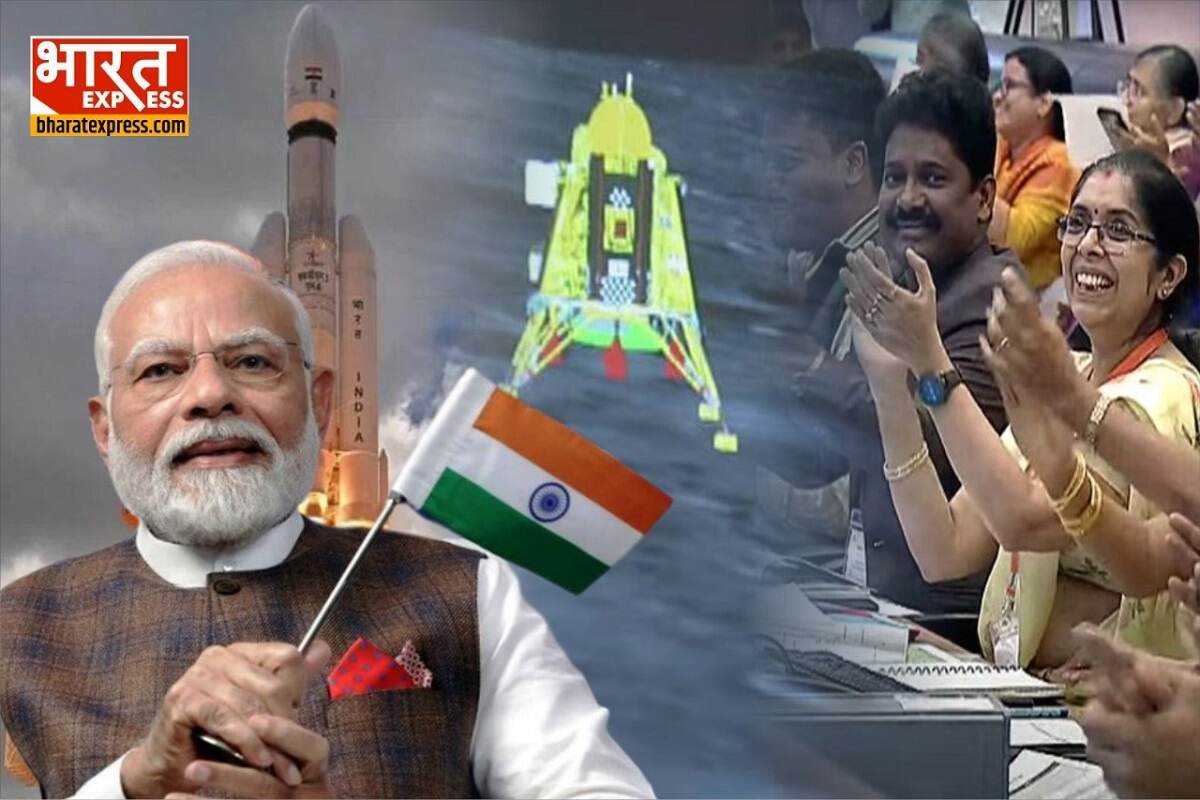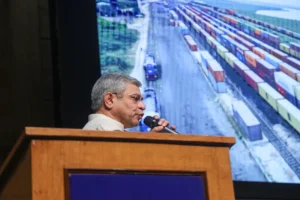
Moon Mission
In the history of space science, the date of August 23, 2023, has been recorded as a golden achievement for India. At precisely 6:04 PM, when India’s Chandrayaan-3 landed on the lunar south pole, the world was left in awe. Upon reaching the Moon, Chandrayaan-3 sent a message: “I have reached my destination and you too…” Here, “you” symbolizes the entire Earth. This achievement belongs to all of humanity.
“India is now on the Moon” – As soon as Indian scientists announced this, the entire nation erupted in celebration. The entire world was astounded. This was the first time a spacecraft from any country had successfully and safely landed on the lunar south pole. Before India, America, Russia, and China had also attempted this feat, but they had not succeeded.
Prime Minister Narendra Modi, who had gone to South Africa to participate in the BRICS summit, was eagerly awaiting this moment. From South Africa, where Mahatma Gandhi had initiated his Satyagraha against discrimination among people, Prime Minister Narendra Modi addressed the nation and the world with pride.
He said, “Such historic events become an eternal consciousness of national life. This moment is unbelievable. This moment is wonderful. This moment is the clarion call of a developed India. This moment is about crossing the ocean of challenges. This moment is about walking on the path of victory.”
The significance of Chandrayaan-3’s success becomes even greater because in the last 4 years, several countries in the world have made similar attempts continuously, but all have failed. The failure of Russia’s Luna 25 mission is a recent example of this. Many heads of states and scientists from around the world, including NASA, have congratulated India and Indian scientists on this magnificent success. Not only that, everyone has expressed pleasant surprise at India’s capability.
The British daily, The Guardian, has described this achievement as unprecedented, stating that India has now joined an elite group of space powers. David Von Drehle, Deputy Opinion Editor for the Washington Post, hailed the accomplishment as “symbolic of a pivotal moment in geopolitics.” The Economist highlighted India’s “lunar triumph” executed with flair, while also pointing out that the landing aligns with PM Narendra Modi’s nationalist narrative in the lead-up to the general elections next year.
While the journey to this achievement had its challenges, its conclusion was flawlessly executed. Remarkably, the mission’s budget-conscious approach is noteworthy; some movie productions have cost more than this space endeavor. For perspective, the mission’s total budget of Rs 615 crore stands in contrast to Hollywood’s Interstellar, which had a cost of Rs 1062 crore, and the blockbuster movie Gravity, produced on a budget of Rs 644 crore.
On July 14 at 3:35 a.m., Chandrayaan-3 was launched from Sriharikota in Andhra Pradesh. By August 23 at 6:04 p.m., it had touched down on the moon’s south pole. Chandrayaan-3 traversed a distance of 384,000 kilometers over 41 days.
Following the success of Chandrayaan-3, India is poised to tap into emerging markets. Potential avenues for trade include space commerce, cryogenics, rocket science, space research, the drone industry, data analytics, data storage, artificial intelligence, GPS research, and remote sensing.
Companies like SpaceX from the United States view lunar transportation as a lucrative future venture. With Chandrayaan, India is well-positioned to secure a stake in this expanding market. As per PricewaterhouseCoopers (PwC) projections, lunar transportation could become a $42 billion industry by 2040.
The moon remains a mystery for scientists all over the world. There is a race among various countries to touch the moon. The question is, has the global race to the moon reinitiated?? This is pertinent because, over the past few years, the entire world has been vigorously endeavouring to reach the moon. From next year until 2027, there are eight more launches planned solely for the moon.
NASA, which had seemingly abandoned the moon for nearly 50 years, plans to launch the Artemis-2 moon mission in 2025, aiming to land humans on the lunar surface once again. Before that, the US is set to send two more missions to the moon this year.
On the other hand, Russia, which last touched the moon 47 years ago, launched its moon mission Luna-25 on August 10 this month, but it crashed. Meanwhile, in 2024-25, Japan will launch its moon mission LUPEX. China will send three missions to the moon between 2024 and 2027. In 2030, China will send its first human mission to the moon. Israel is also launching Beresheet 2 in 2024, a long-term mission in which, for the first time, two landers are being sent simultaneously.
But why has the world’s interest in Earth’s lone satellite been reignited? Roscosmos, the Russian Space Agency, has announced plans to establish a self-sustaining permanent human colony on the moon. This means it aims to create an environment where oxygen, water, and food can be produced to support human life. Such ambitions are based on the potential presence of oxygen and water on the moon’s southern pole. In fact, it was ISRO that first detected traces of water on the moon in 2009. These groundbreaking discoveries could set the stage for a permanent lunar station. One driving force behind the renewed lunar exploration is the potential abundance of mineral deposits beneath the moon’s surface.
NASA was the pioneer in uncovering the moon’s concealed riches. During the Apollo 17 mission, NASA revealed the presence of a thin layer of gases on the moon, including helium, argon, and neon. This suggests a vast reserve of helium-3 on the moon, a potential energy source that could sustain Earth’s energy needs for countless centuries while being environmentally benign. The moon harbors approximately one million metric tons of helium-3, which is a hundredfold greater than Earth’s reserves. If merely a quarter of this amount, roughly 250,000 tons of helium-3, were harnessed and transported to Earth, it could cater to our energy demands for the next five centuries.
Besides helium-3, scientists are exploring the moon for various other valuable materials. Some researchers assert that the craters on the moon’s south pole have remained in darkness for about 2 billion years, with temperatures plummeting to as low as minus 203 degrees Celsius. Owing to these extreme conditions, substances buried in the lunar soil have been preserved for millennia, potentially aiding in unraveling Earth’s origin mysteries. In this endeavor, India can assume a pivotal role.
India’s foray into space continues unabated, with the moon being just one milestone. As part of India’s ambitious space program, ISRO is gearing up this year to send astronauts into space and ensure their safe return. The preparations for the human-centric mission, dubbed Gaganyaan, are nearing completion. Moreover, by 2030, ISRO aims to establish a space station, enabling sustained exploration of space. In connection to this initiative, two rockets are anticipated to launch by 2025. Furthermore, ISRO has plans in motion for Shukrayaan-1, a mission to Venus, and Aditya L-1, designated to study the sun, extending its research beyond the moon and Mars.
Today, India has touched the moon, but the journey to this point was fraught with challenges. Indian scientists navigated numerous obstacles to achieve this milestone. The saga began 60 years ago, on November 21, 1963, when Vikram Sarabhai embarked on a space quest, transporting a partially assembled rocket, procured from the American space agency NASA, on a bicycle. He even repurposed a church in Thiruvananthapuram, Kerala, into a makeshift space station. Six decades later, this journey has culminated with a mission to the moon. In a fitting tribute, India named Chandrayaan-3’s lander in honor of Vikram Sarabhai, rightfully acknowledged as the father of India’s space program. What was initially known as INCOSPAR (Indian National Committee for Space and Research) eventually evolved into ISRO.
India’s inaugural satellite, Aryabhata, launched on April 19, 1975, was operated from a data center located within a restroom in Bangalore. By 1980, as the Indian Space Research Organisation (ISRO) was gearing up to launch the Rohini satellite, it employed a bullock cart to move the rocket’s payload, leaving the global community astonished. That same year, Rohini successfully entered Earth’s orbit. The 1983 inception of INSAT, the Indian National Satellite Network, marked a significant stride for the nation. By 1993, ISRO had effectively tested both the PSLV and GSLV. The Chandrayaan 1 mission in 2008 joined an elite group of endeavors that reached lunar orbit. The Mars Orbiter Mission, unveiled in 2014, captivated the global audience. In 2017, ISRO etched a record by simultaneously launching 104 satellites, encompassing both Indian and international ones. Continually setting benchmarks, ISRO has evolved into a global leader in commercial satellite launches. Over its 60-year trajectory, ISRO has deployed 424 satellites from 34 nations, boasting a success rate exceeding 80% in its space missions. With constrained resources, Indian scientists have showcased their prowess, further consolidating it with their expedition to the Moon’s South Pole.
The success of Chandrayaan-3 marks a pivotal moment for India’s aspirations of establishing a lunar base. However, its primary objective remains centered on human welfare. Scientific advancements should always prioritize the betterment of humanity. Upholding the principle of “Vasudhaiva Kutumbakam,” which translates to “the world is one family,” India has consistently prioritized humanitarian goals. This perspective is further echoed by Prime Minister Narendra Modi, who lauds the success of Chandrayaan-3 as a triumph for all of humanity.



















